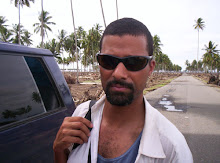 Last year, geologist Katrin Monecke and co-authors published a paper in Nature that showed the last tsunamis in Aceh occurred in 1907, ~600 years ago, and ~1000 years ago (Monecke et al., A 1,000-year sediment record of tsunami recurrence in northern Sumatra, Nature 455, 30 October 2008).
Last year, geologist Katrin Monecke and co-authors published a paper in Nature that showed the last tsunamis in Aceh occurred in 1907, ~600 years ago, and ~1000 years ago (Monecke et al., A 1,000-year sediment record of tsunami recurrence in northern Sumatra, Nature 455, 30 October 2008).One of the areas described in the paper is shown above. This is a landscape of beach ridges separated by low-lying, swampy swales. It is in these swales that the paleotsunami deposits are found. In March 2009, we went back into the field to collect data to help determine how these ridges were formed.
One of the interesting aspects of these deposits in this area is that the oldest deposits (from 1000 years ago) occur only in the swales furthest from the modern beach. So, where was the beach when these sediment were deposited? How much has the coastline grown outwards since their deposition?
To answer these questions, we will attempt to date the ridges using thermolumniescence. Some minerals, when exposed to light, store heat in their crystal structures. When these samples are heated again, they emit light (luminesce) in a way that is related to how long ago they were removed from the light source. Really smart people can then determine the age of a sample based on the light the mineral emit when heated. Pretty cool!
We collected several samples from a village north of Meulaboh, NAD (Aceh Province), to see if this method is feasible here. If so, a group of researchers from the Netherlands will come back and do a full dating campaign, and by determining the timing of ridge formation, we can possible determine how the ridge was formed.
When you see a repeating pattern in nature, such as the ridges pictured above, there is often a recurring event that is responsible for their formation. Terraces step down the mountains around Santa Cruz, California, that we formed by changes in sea level. Rings around corals in the islands offshore Sumatra are formed when earthquakes lift the coral partially out of the water, killing the top animals of the colony. Following the 2004 earthquake, the coastline in this area subsided several tens of centimeters, so it begs the question- Could subduction zone earthquakes somehow be responsible for beach ridge formation?
Doubt it.
James Goff, director of the Australian Tsunami Research Centre, showed that in New Zealand, beach ridges are formed when pulses of sediment are delivered to the coast following massive landsliding triggered by earthquakes. There was not widespread landsliding following the 2004 earthquake, so it is unlikely that there would be the sediment available to create another ridge. Furthermore, as the coast subsided, a lot of land was actually lost, presumably to the offshore. Please, prove me wrong- it would be really helpful if these ridges were actually related to the subduction zone earthquakes!
It might be that the beach ridges are formed following earthquakes on the Great Sumatra Fault- the big strike-slip fault that runs through the Sumatra highlands. If the dates from the ridges correlate with this earthquake history, then it is likely that landslides in the highlands provided the sediment for their formation, and that they are just a convenient "catcher's mit" for tsunami sediment.
Or, perhaps they were formed by volcanic activity, as suggested by Stanford geology student Mindi Summers in her senior thesis on beach ridges in New Zealand. Another day....






